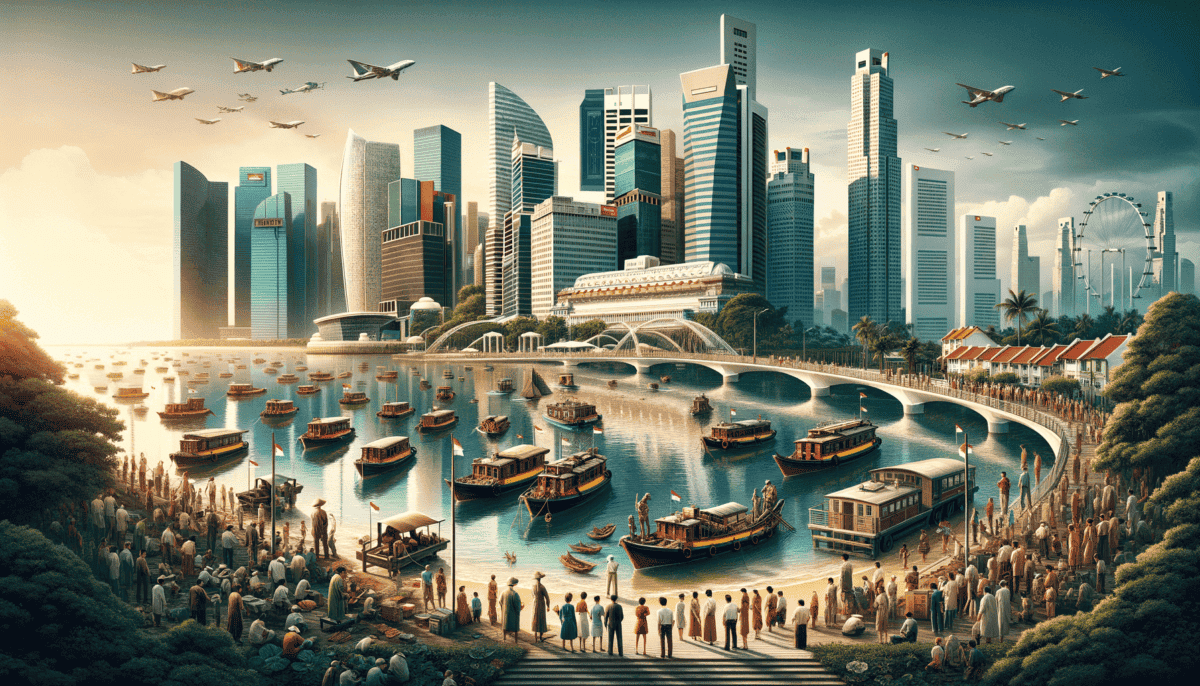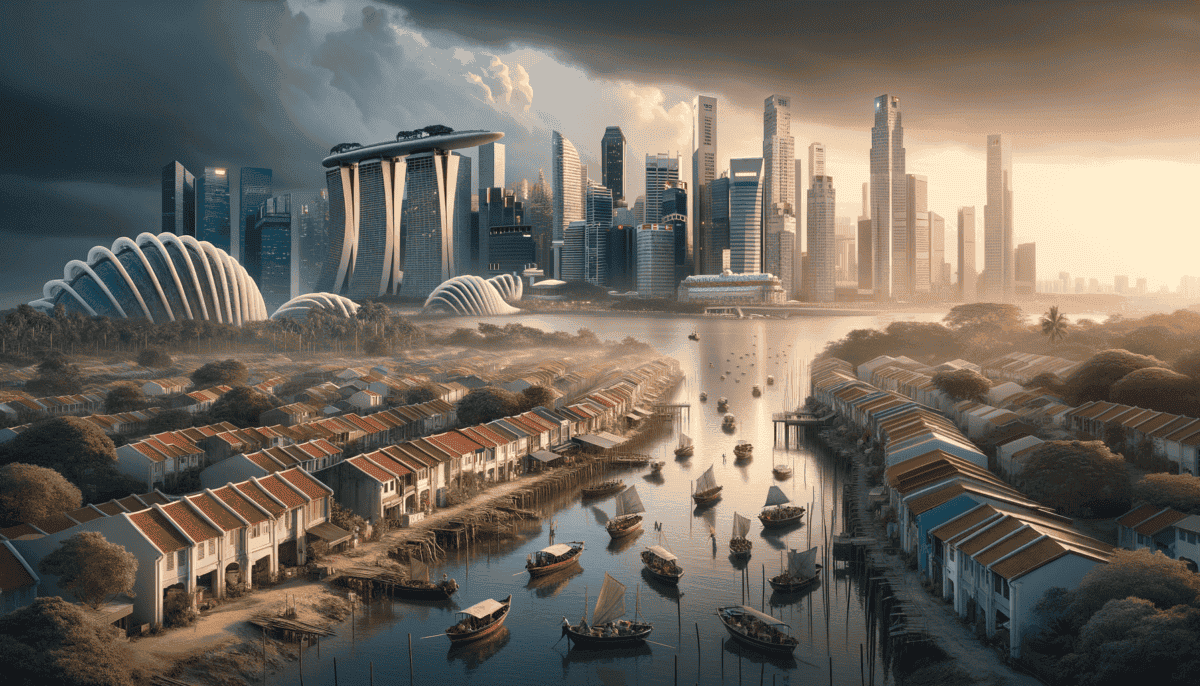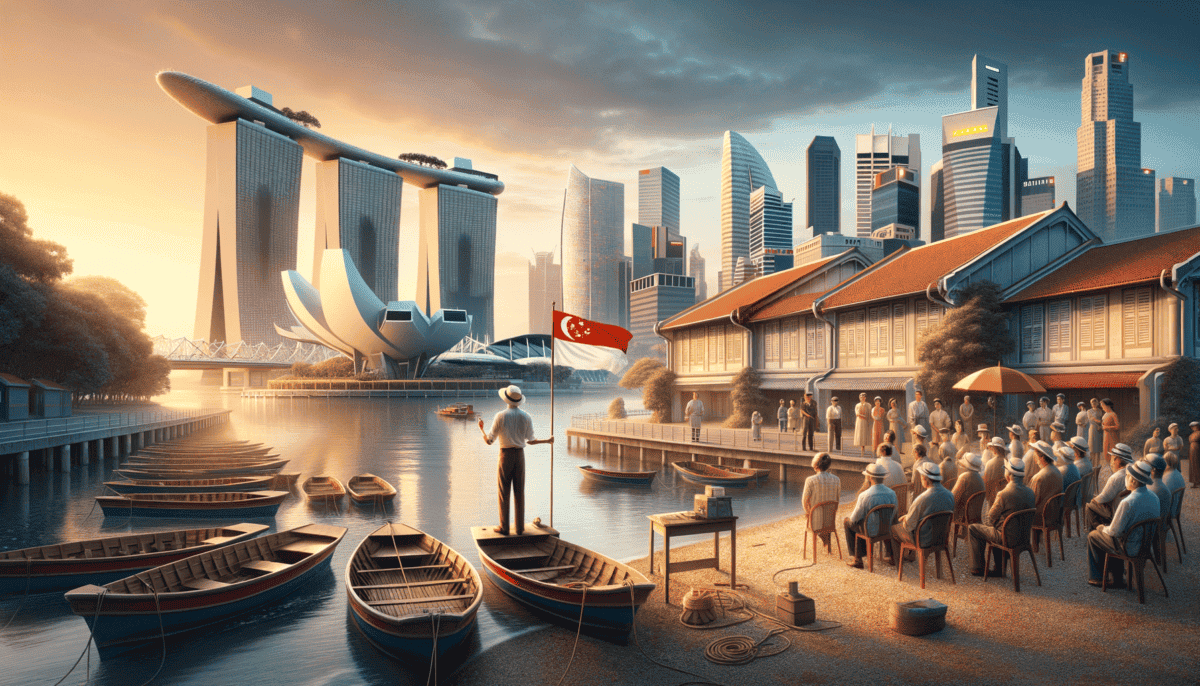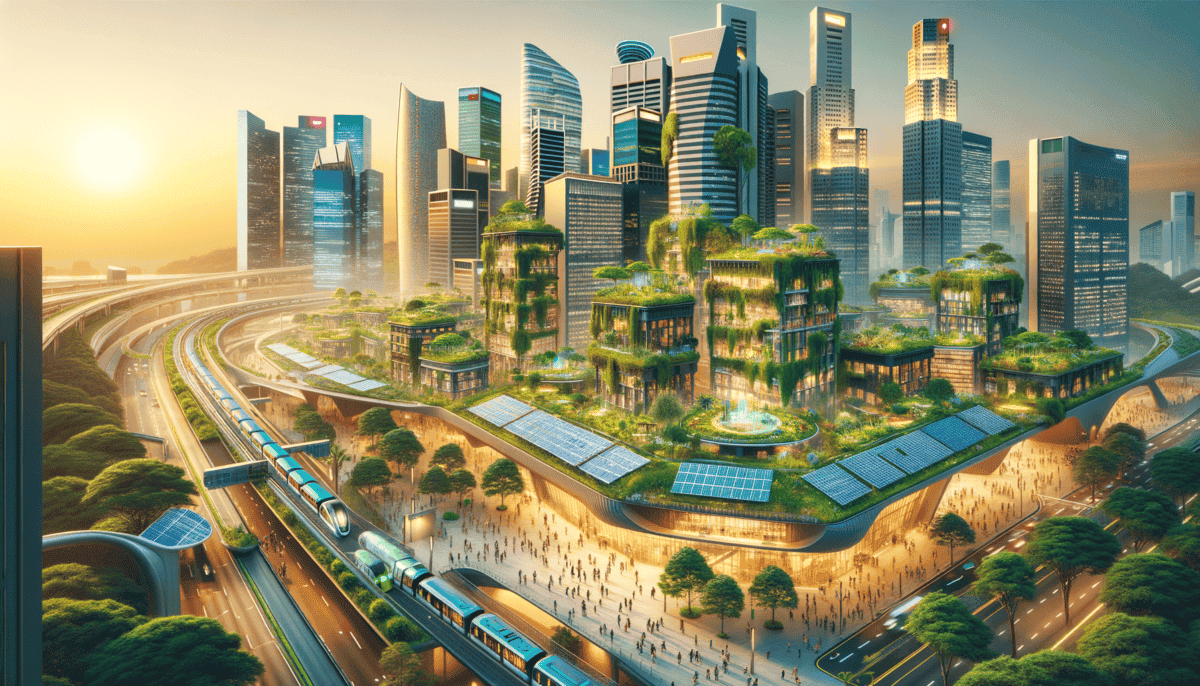A Magical Lion’s Discovery
Long ago, on a tiny island covered in thick green jungle, something amazing happened. The warm sun sparkled on the blue waters around the island, where small fishing boats bobbed up and down like tiny toys.
"What could be hiding in this mysterious place?" wondered Prince Sang Nila Utama, as his ship sailed closer to the shore. The young prince from Sumatra had never seen such a beautiful island before.
As he stepped onto the sandy beach, something caught his eye. Through the dense trees, a strange animal moved with grace. It had a red body, a black head, and a magnificent mane.
"Look!" he shouted to his friends. "A lion! This must be a special place!"
The prince decided to name the island "Singapura," which means "Lion City" in Sanskrit. Even though what he probably saw was really a tiger (since lions never lived on the island), the name stuck!
“This will be a great city one day,” the prince declared, looking at the fishing village before him. Small wooden houses stood on stilts over the water, and friendly fishermen waved from their boats.
The island was perfect for ships to stop and rest. It had a deep harbor where boats could safely anchor, and fresh water from streams flowed down from the hills. The local people, called the Orang Laut (sea people), knew all about the waters around their home.
Life in the Ancient Village
Every morning, the village would come alive with activity:
• Fishermen paddled out in their boats
• Children played along the shore
• Women dried fish in the sun
• Traders from far away lands visited to trade spices and silk
Little did these villagers know that their tiny island would one day become one of the most amazing cities in the world!
The air smelled of salt and fish, and the sound of waves mixed with children's laughter. People lived in simple houses made of wood and palm leaves, raised above the water on strong poles.
Different people began to visit the island. They came from China, India, and Arab lands. Each brought their own special foods, clothes, and ways of living. This made Singapore an exciting place where many cultures met and shared their stories.
"My grandfather says more ships come every year," a young boy told his friend as they watched a large trading vessel enter the harbor. "Maybe one day, this will be the busiest port in all the seas!"
The warm breeze carried the scents of cooking fires and exotic spices through the village. As the sun set, the sky turned orange and pink, painting the peaceful scene in magical colors.
The island held so many secrets and so much promise. What amazing things would happen here? What would this small fishing village become? The story of Singapore was just beginning, and nobody could have guessed the incredible journey ahead.
A Port is Born
On a steamy morning in 1819, a tall ship with white sails appeared in Singapore’s harbor. On board was Sir Stamford Raffles, a man with big dreams for this little island.
“This is perfect!” Raffles said, looking at the busy fishing boats and deep blue water. “We can build something amazing here.”
Raffles met with local leaders and made a deal. The British would help protect the island, and in return, they could build a trading port. It was like making Singapore into a giant store where ships from all over the world could buy and sell things.
A City Grows Up
Changes happened fast! Workers built new roads and buildings. Ships from many countries started visiting the port. The air filled with exciting sounds:
• Chinese merchants selling tea
• Indian spice traders calling out their wares
• Malay fishermen bringing in fresh catches
• British sailors loading and unloading cargo
Different people brought their own special foods and traditions. Soon you could smell curry cooking next to Chinese noodles, while Malay satay sizzled nearby.
“Look how many different languages we hear now!” a little girl said to her mother as they walked through the busy market. “I want to learn them all!”
The British built neat rows of shophouses – buildings where families could live upstairs and run stores downstairs. They painted them in pretty colors like pink, blue, and yellow. Many of these houses still stand today!
Everyone Works Together
People from different backgrounds learned to work and live together. Chinese carpenters worked next to Indian builders. Malay sailors helped guide ships into the harbor. Everyone had an important job to do.
“My father says Singapore is like a big family now,” said a young boy helping in his family’s shop. “We all help each other.”
The port got busier and busier. Ships brought things like:
– Silk from China
– Spices from India
– Tea from Ceylon
– Cotton from England
At night, the waterfront glowed with lanterns. The smell of the sea mixed with cooking spices. People spoke in many languages as they walked home after a long day of work.
New schools opened where children could learn to read and write. Hospitals were built to keep people healthy. Gardens were planted to make the city beautiful.
“Singapore is changing so fast,” an old fisherman said to his grandson. “But it’s changing in a good way. We’re becoming something special.”
The little fishing village was growing into a big, important city. But even bigger changes were coming. The people of Singapore would soon face their biggest challenge yet, and they would need all their courage to get through it.
Dark Days and Brave Hearts
The sunny days of Singapore turned dark on February 15, 1942. Japanese planes flew over the city, and big ships appeared in the harbor. It was the start of a very hard time. ️
“We must be brave,” whispered Mrs. Chen to her children as they huddled in their home. “We will get through this together.”
Life Changes
Everything changed when the Japanese took over. They gave Singapore a new name: Syonan-to, which meant “Light of the South.” But life was not bright at all.
Food became hard to find. People had to grow vegetables in any space they could find. Some planted sweet potatoes in their backyards. Others grew tapioca in empty lots.
“Look, Ahmad! Our first potato plant!” Maria exclaimed to her brother. “Now we can help feed our family.”
Schools closed, and children had to learn new rules. Everyone had to learn Japanese words and bow to Japanese soldiers. Money changed too – people used Japanese dollars called “banana money” because they weren’t worth much.
Heroes of Hope
Even in the darkest times, people found ways to help each other:
– Neighbors shared food with those who had none
– Doctors helped sick people in secret
– Teachers taught children in hidden places
– Friends protected each other’s families
Mr. Tan, an old shopkeeper, started a secret garden behind his store. “Every morning, I share vegetables with five families,” he told his daughter proudly. “We must take care of each other.”
Stories of Courage
Elizabeth Choy became a real hero during this time. She smuggled food and medicine to prisoners who needed help. Even when she got caught and was hurt, she never stopped being brave.
“My mother says Elizabeth Choy shows us what it means to be strong,” said little Mei Ling to her friend. “She helps others even when it’s scary.”
People found creative ways to keep their spirits up. They told stories at night. They sang quiet songs. They drew pictures and wrote poems about better days to come.
Hope Returns
Finally, in September 1945, good news came. The war was over! Singapore was free again. People came out of their homes, crying with joy and hugging each other.
“Look!” shouted Kumar to his friends. “British planes are dropping food packages from the sky!” People ran to catch the boxes full of rice, sugar, and other supplies.
The hard times taught Singapore’s people important lessons. They learned that:
- Together, they could survive anything
- Being kind to each other makes everyone stronger
- Hope never dies if you keep it in your heart
As Singapore began to rebuild, people remembered how they helped each other during the dark days. This memory would make them stronger as they faced their next big challenge: becoming their own country.
The sun was rising again over Singapore, and with it came dreams of a new tomorrow. But first, the people had to decide what kind of country they wanted to be.
Dreams of Freedom
The year was 1965. Singapore stood at a crossroads. After leaving Malaysia, the tiny island had to find its own way. But a special leader named Lee Kuan Yew had big dreams for his country.
“My fellow citizens,” he said, his voice shaking, “We are now in charge of our own future.”
Starting Fresh
Being a new country wasn’t easy. Singapore was small and had no natural resources. Many people were poor and didn’t have jobs. But Lee Kuan Yew had a plan.
“We may be small, but we can be mighty,” Lee told his team. “We will make Singapore shine!”
First, they needed homes for everyone. New buildings called HDB flats started going up all over the island. Families moved from old wooden houses to clean, modern apartments.
“Look, Mama!” little Ali called from their new balcony. “I can see the whole city from here!”
Building Dreams
Singapore’s leaders worked hard to make the country better:
- They built new schools so children could learn
- They cleaned up the streets and rivers
- They planted trees to make the city green
- They helped people find good jobs
The most important thing was bringing people together. Chinese, Malay, Indian, and other groups learned to live and work as one family.
Growing Strong
Like a small plant growing into a strong tree, Singapore began to change. Big ships came to the port. New factories opened. More people found jobs.
“My daddy says Singapore is like a garden,” said Mei Hua to her classmates. “We all help it grow by working hard.”
Children went to school to learn new things.
Workers learned special skills for better jobs.
Everyone worked together to build their country.
A New Song
Singapore got its own flag – red and white with five stars and a moon. It also got a special song called “Majulah Singapura” which means “Onward Singapore.”
“When I hear our song,” said Mr. Rahman to his students, “I remember how far we’ve come and how far we can go.”
The country was changing fast. New roads appeared. Tall buildings reached for the sky. Gardens bloomed where there used to be swamps.
Looking Forward
Lee Kuan Yew knew Singapore needed to think big. He wanted his country to be clean, green, and smart. He wanted everyone to have a good life.
“Every day is a new chance to make Singapore better,” he would say. And every day, the people worked to make that dream come true.
As the sun set on another busy day, little children played in new playgrounds, workers headed home to their families, and the lights of the growing city twinkled like stars. Singapore was becoming something amazing – a tiny island with enormous dreams.
But the best was yet to come. Singapore was about to show the world what a small country with big ideas could do.
Money Magic
The little island of Singapore was ready for its next big adventure. Like a caterpillar turning into a butterfly, Singapore was changing in amazing ways.
Smart Choices
“We have no gold mines or oil wells,” said Mr. Lee to his team. “But we have something better – we have smart people!”
Singapore made clever plans to grow:
- Built a super modern airport
- Made the port bigger for more ships
- Invited big companies to open offices
- Taught workers new computer skills
The Big Change
Where there were once empty fields, tall office buildings reached toward the clouds. The busy port filled with colorful ships from all over the world. ⛴️
“My daddy used to drive a taxi,” said little Ming. “Now he works with computers in a big company!”
Money Magic
Banks from all around the world came to Singapore. The city became like a piggy bank for Asia!
People saved money in Singapore’s banks.
Big companies traded on Singapore’s stock market.
New jobs appeared every day.
Smart City, Smart People
Singapore knew that smart people were its secret weapon. New schools and universities opened. Children learned about computers and science. ️
“When I grow up,” said Aisha to her teacher, “I want to be a robot engineer!”
Clean and Green
Even as Singapore got richer, it stayed clean and green. Trees lined the streets. Gardens bloomed on top of buildings. The air stayed fresh and clear.
“Our city is like a garden,” said Mr. Tan to his students. “We make money grow, but we also make flowers grow!”
Shopping Paradise
Orchard Road became famous around the world. Bright lights twinkled on fancy shops. People came from everywhere to shop and have fun. ️
“Look at all the pretty lights!” squealed Sarah as she walked with her parents. “It’s like Christmas every day!”
A Special Place
Singapore became known as a special place where things worked well. The buses ran on time. The streets were safe. Everyone had a chance to do well. ⭐
“My grandpa says Singapore is like magic,” said Kumar. “It makes dreams come true if you work hard.”
At night, the city sparkled with millions of lights. From high up in their HDB flats, families could see their amazing city growing and changing. But Singapore wasn’t done yet – it had even bigger dreams for the future!
As more buildings reached for the stars and more people came to visit, Singapore showed the world that a small country could do big things. The little fishing village had become a shining star of Asia.
Tomorrow’s Garden City
The sun rises over a Singapore that looks like something from a dream. Flying taxis zoom between green buildings. Gardens float in the sky. This is Singapore today, but what about tomorrow?
Living in the Sky
“Look, mama!” little Mei points up at a building covered in trees. “The building is wearing a forest!”
Singapore’s new buildings are special. They’re not just homes and offices – they’re gardens too!
Smart City Magic
Singapore uses special computer magic to make life better:
- Robots that clean streets
- Lamp posts that can talk
- Trees that send messages when they need water
- Cars that drive themselves
Green Dreams
“Our city will be the greenest in the world,” says Mr. Lim to his class. The children’s eyes sparkle with excitement.
“We’re planting one million trees!” shouts Tommy. “I helped plant three already!”
Fun in the Future
New places to play and learn are popping up everywhere:
A park that floats on water
Museums where art comes alive
Gardens with glowing trees at night ✨
Playgrounds that make their own energy
Saving Our Earth
Singapore is working hard to help save the Earth. Solar panels catch the sun’s power. Special machines turn trash into treasure.
Friends Around the World
People from everywhere come to learn Singapore’s secrets. How to build cities in the sky. How to make gardens grow on buildings. How to keep air clean and fresh.
“Singapore teaches us that small can be mighty,” says a visitor from far away. “Dreams can come true!”
The Big Dream
From a tiny fishing village to a magical city of the future, Singapore’s story is about believing in dreams. It’s about working hard and being smart. It’s about taking care of each other and our Earth.
Little Sarah looks up at the stars twinkling above Marina Bay. “What will Singapore be like when I grow up?” she asks her grandfather.
He smiles and hugs her tight. “Even more magical than today, my dear. In Singapore, we never stop dreaming big!”
And so, as the sun sets on our story, Singapore continues to grow and change. New dreams bloom like flowers in a garden. New ideas spark like stars in the night sky. The little red dot on the map keeps showing the world that anything is possible when you believe in tomorrow.






